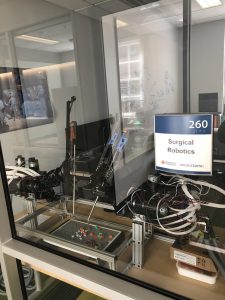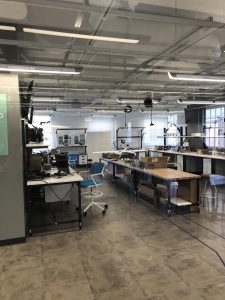
This past month, UVa’s School of Engineering opened its state-of-the-art Link Lab, located on the 2nd floor of Olsson Hall. The lab was created thanks to a 4.8 million-dollar contribution from UVa’s Strategic Investment Fund and will serve as a leading research center in the world of Cyber-Physical Systems.
Cyber-Physical Systems (or CPS) are engineered systems that are built from, and depend upon, the integration of computation and physical components. Essentially, these systems serve as the link between computers and our material world. Current examples include “smart cities,” smart health products, and autonomous vehicles.
The Link Lab’s aim is to harness development of these projects through a collaborative and open approach. Program Director Travis Hite explained to WUVA News what makes Link Lab’s working environment unique.
“The space itself is this open concept for both the graduate students and faculty,” he said. “The idea behind that is the university trying to push the workspace for its faculty and students into a more modern structure. We see this popping up at places like Google and Facebook and start-ups.”
This environment will allow for a more cohesive and integrated approach, as faculty and graduate students will not be surrounded by their usual teams, forcing the desired, interdisciplinary type of collaboration to move forward.
“The students and faculty aren’t in blocks of their discipline. Everyone is intermixed. Real engineering is like jamming together all these different disciplines and all this other knowledge into a solution,” Hite explained. “That’s kind of like what Link Lab is, we literally jam together all these faculty and all these students to create these new projects from the ground up.”
And it has worked. Research from the lab has already brought in more than $14 million dollars this fiscal year, allowing this interdisciplinary approach to research in the Link Lab to generate real results.
However, it is not just interdisciplinary work within various divisions of engineering that is important. Hite said that the experience of working with people from entirely different sectors of the field is a crucial skill for the modern-day engineer.
“To be a more effective engineering student is to come out of your degree program, no matter what level, having the knowledge that problems in the real world are broader than what your single discipline is,” he explained. “And that’s what Link Lab is here to do. To have research, have faculty, have students that through their education, can…address real problems.”

And these real world solutions are actually part of the lab itself. A surgical robot that is on display was constructed by a team in Link Lab and is used for surgical procedures at the UVa Medical Center. Hite explained that surgeons come from the hospital and work with the students to explain what they need out of the robot. Subsequently, the students get to go to the hospital and do rounds with the surgeons as well as view a surgery where the robot was used, allowing innovation in Cyber-Physical Systems to integrate vastly different fields for beneficial advancements.
Although the students in the lab are graduate students, Hite said that there are ways for undergraduate engineers to get involved as well.
“Look across the faculty list, if there is a certain field or research study that interests you, reach out to that faculty member. They are always there to be a resource,” he explained. “They can also reach out to me. As program director for the lab, I have a pretty broad view of what we’re doing and how you can be involved.”

To Hite, the future looks promising for Link Lab and Cyber-Physical Systems more generally, all thanks to interdisciplinary collaboration.
“Getting into the true multi-disciplinary is crucial,” he said. “We can design the tech but the next questions that need to be asked are how we can design the world around it.”
















